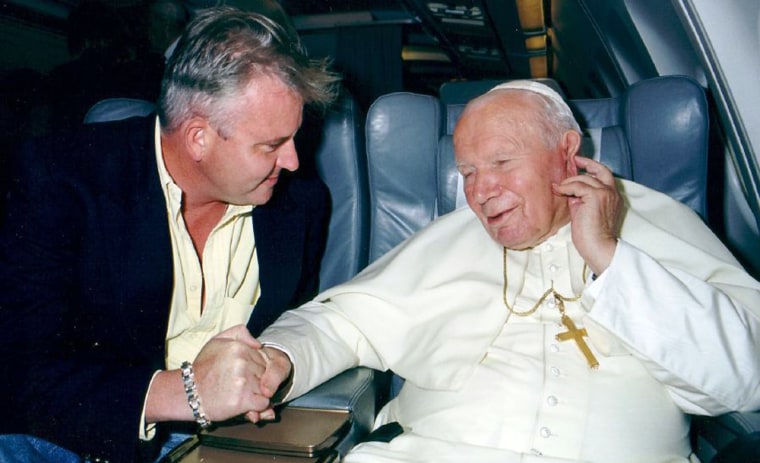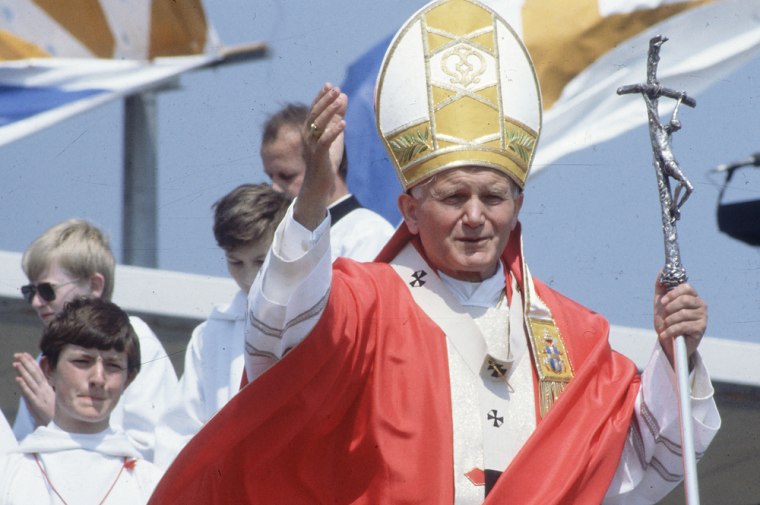My first pope trip was John Paul’s trip to England and Scotland in the early summer of 1982. I was the light/bag & ladder carrier for the ABC News crew and I was 20 years old. That trip was also the first ever visit of a Roman Pontiff to the country that had separated from Catholicism under Henry VIII.
That trip took place on the tumultuous stage of its time.
The civil war in Beirut was blazing. Yasser Arafat had taken refuge in the heart of the city with his PLO fighters, and then General Ariel Sharon led an invasion of Lebanon to oust him.
England was at war with Argentina over the windswept Falkland (Malvinas) Islands, and the pope’s trip to England had to be balanced for fairness with an unscheduled trip to Argentina.
Meantime, the trial of the Turkish assassin who had shot the pope was under way in a special maximum-security bunker courtroom.
The Cold War was in full swing and the world's media were gathered at the trial of Mehmet Ali Agca waiting for the exposure of a suspected Soviet plot to kill the pope. It had only been a year since the shooting in St. Peter’s Square and the 62-year-old pontiff was still recovering from the severe abdominal wounds.
John Paul II was then already a heroic figure of global fame. He was young, strong, and captivating. He was humble but fearless, and he had launched his moral assault on the Communist dictatorship of Poland.
Getting on the papal plane was an honor and a privilege for me, and I was blown away by the caliber of the media on board, of which I was the youngest member in the unglamorous role of ABC sherpa.
Excitement of covering the ‘newsy’ pope
The plane was a narrow-bodied Alitalia aircraft with three seats on each side of the aisle. The pope sat in the first-class section up front, his entourage and security sat in the next business class section, and buffered him from economy where the media rode. The atmosphere in coach was almost frat-house like.
Nobody wore seatbelts. Camera gear and photo equipment lay everywhere on airplane seats. These were the early 80’s and everybody still smoked and drank the hard stuff, especially in Europe. The first thing the flight attendants gave us was a carton of cigarettes and a box of designer perfume.
There was a feeling of new adventure to it all. This was John Paul’s 12th foreign trip and he had already drawn the massive crowds that would mark his papacy.
Best of all, Pope John Paul II was “newsy.” He made news, and nothing pumped up journalists like knowing they were going to get their story on front pages and tops of newscasts.
For the photographers and camera people he was a dream. He always gave us something to shoot. Gestures, facial expressions, and his trademark action upon arriving to a new land: bounding vigorously down the airplane steps, kneeling and bending down to kiss the ground.
In-flight press conferences
But the coolest thing about being on that plane was the fact that this was the only place the pope made himself available to the media for questions. About an hour into the flight the overhead lights would come on and the curtain to the entourage section would stir with activity.
The benign anarchy in the press section snapped into a crush of bodies. The huge RCA video cameras of the time were hauled onto shoulders, 50 bodies pressed against each other with microphones poking through, and hand recorders stretched forward.
A reverential self-restraint took over the pack, while elbows were still jammed into the ribs of the next guy if he tried to get into your shot.
Into that fracas dived John Paul, with a big smile on his face and his deep voice saying, “Calmi, calmi” (calm yourselves).
And then the banter began in earnest. He responded to a rain of questions in a multitude of languages, shifting effortlessly from Italian to English, German, French, Spanish and Polish.
I stood right behind him throughout; my job there to hold up one of those obnoxiously bright TV lights up at the ceiling to provide adequate light for all the TV cameras. With my other hand I held up my Nikon to record the moment!
He answered everything. Politics, religion, morality, philosophy rolled off his tongue and if he thought somebody was pushing it, he would wag a finger with a twinkle in his eye, but he would still answer the question, if only to sidestep it or turn it back on the reporter.

That trip was unforgettable for me and would influence many of my choices in life. After that I spent a dozen years in America for college, and years in local news in San Francisco.
When NBC hired me in 1996 and sent me back to Rome to cover the pope again, I found a much older man.
History overshadowed by scandal
The Parkinson’s disease was beginning to kick in in earnest. The early nineties had seen him hospitalized several times: a broken hip, a fractured shoulder, and worst of all a benign tumor in his colon the size of an orange. Soon after I arrived he was hospitalized again for an appendectomy and the removal of intestinal adhesions caused by the scarring from the shooting in 1981.
But he kept on traveling. The days were shorter and he didn’t squeeze six or seven different events into a day like he could in the 80’s, but he drew the crowds and covered the miles.
I went on almost all the trips of the last nine years and was impressed with the huge physical effort it now took him to do the simplest things.
There were still some memorable trips in these latter years, like Cuba to meet President Fidel Castro.
That was a fateful trip because when we took off in the plane that morning in Rome the event we were covering was the biggest story on the planet. But when we landed the sound technician who was wiring me up for my first network live shot said to me, “Did you hear about Clinton?” I said I hadn’t. “He had sex with an intern.”
The famous Jim Lehrer interview with the former president had broken while we were airborne. History gave way to scandal in short order as Lear jets were scrambled for the network anchors — Tom Brokaw, Dan Rather and Peter Jennings — to fly to Washington just hours after the pope landed.
What was supposed to be full network coverage and the first-ever live anchoring from Havana was quickly reduced to voice-over status.
Still using the media to send out his message
That flight was significant to me for another reason though, because it would be the last time John Paul came back to the press section of the plane to answer questions. It was January 1998. With great effort and a left hand shaking very hard he spent a good 20 minutes with us, and gave Castro a few hard knocks for oppressing religious freedom.
John Paul was very clever in his use of the media with these airplane sessions. He knew that the technology now allowed us to communicate with the ground in flight, so the wire services would move his comments within the hour, sending a public message to the leaders of the country he was visiting.
Especially in trips to dictatorships and authoritarian regimes he would use this tactic to great effect, but this time there’s a funny story to go with it too. The airplane phones that cost $10 a minute with a credit card swipe didn’t work on this Alitalia plane, so the only way to call out was on a satellite phone.
Satellite phones back then were the size of a laptop computer and the lid worked as an antenna that had to be pointed at the satellite. The only guy with a sat-phone on the trip was the Polish TV correspondent. He was able to get a signal out of the left side of the plane, which was a very large Airbus.
The lead wire reporters — the Associated Press’ Vic Simpson and Reuters’ Phil Pullella — were in a bidding war with cash to be first to call out. A long line of other journalists were crowded behind them. Satellite phone minutes were extraordinarily expensive so the Pole was raking in large dollar notes from this hankering horde.
Eventually so many people had gathered around the sat phone that the plane began to list to one side, and the flight crew rushed back to order us to get back on each side to balance it out!
But the word got out, and Castro was put on the defensive before the pope even landed. And that’s the last news conference Pope John Paul II would ever give. It would also be one of the last times the pope would be “newsy.”
With the exception of his trip to the Holy Land in the year 2000, the focus was no longer on what the pope said or did, but on how sick he was, how frail he looked, and how long he could lead the church in his condition.
Last trip alone
His death this month was still a shock for those of us who are part of the Vatican press corps. It was the most anticipated death in modern times, and yet the finality took us all aback. The stunned hush that hung in St. Peter’s Square the night of April 2 was so strong you could almost touch it.
The following Monday morning those of us in the Vatican press corps were brought up to see his body before it was transferred to public viewing in St Peter’s Basilica. We stood in a long line for more than an hour. We talked to each other about how strange it was, and how us standing together in a pack felt like another pope trip.
That feeling would grow in me as I experienced the mind-boggling crowd that lined the entrance to St. Peter’s for the days and nights preceding the funeral. There were millions of people there, just like at his most popular venues in big Catholic countries like Mexico and the Philippines.
At night the atmosphere on Via della Conciliazione, the huge boulevard that leads up to the square, became positively surreal. All these people packed together, more than half of them under 25, who had known no other pope, standing patiently, smiling amid this Renaissance architecture while watching huge jumbotron screens that lit up the night with high-tech 3rd millennium live television of the body inside the church.
It felt to me like this really was another pope trip, but this one was different. It really was the last one, because he was going home, and we couldn’t go with him.
